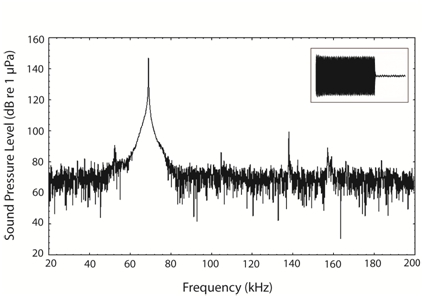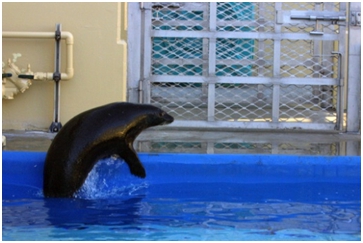Acoustical Society of America
159th Meeting Lay Language Papers
[ Lay Language Paper Index | Press Room ]
Harbor seals (Phoca vitulina) respond with Aversion to 69 kHz Pings: Implications for Weighting Procedures for Marine Mammal Noise Metrics
Ann E. Bowles - abowles@hswri.org
Michael Shane
Stephanie K. Graves
Hubbs-SeaWorld Research Institute
2505 Ingraham Street
San Diego, CA 92109
Samuel L. Denes
Graduate Program in Acoustics, Pennsylvania State University
State College, PA 16802
Popular version of paper 2aNSb8
Presented Tuesday morning, April 20, 2010
159th ASA Meeting, Baltimore, MD
Since the late 1950s, underwater acoustic telemetry has become an increasingly popular tool. Ultrasonic coded transmitters (UCTs) in the 60-80 kHz range are being used increasingly to track fish and invertebrates in coastal and estuarine waters. Although they are called ultrasonic, UCT frequencies lie within the hearing range of some marine mammals. Author Shane tracked cultured white seabass (Atractoscion nobilis) instrumented with 69 kHz ultrasonic coded transmitters (UCTs) in the vicinity of several harbor seals (Phoca vitulina), later finding the bones of fish on the bottom associated with UCTs in two cases. This led us to suspect that seals had targeted and eaten our instrumented fish.
To determine the potential for detection, we measured acoustic properties of UCTs at the U.S. Navy TRANSDEC facility (Figure 1 and 2). Five VEMCO V9-2L-R04K 69 kHz UCTs had source levels ranging from 146 to 149 dB re 1 Pa SPL @ 1 m (0). Five Sonotronics IBT-96-5-I UCTs (69 kHz and 83 kHz) had source levels ranging from 129 to 137 dB re 1 Pa Pa SPL @ 1m (0). Based on these measurements, simple empirical propagation models, and published data on marine mammal psychophysical capabilities, California sea lions (Zalophus californianus) would not be able to hear the pingers, but harbor seals might be able to hear the highest-amplitude 69 kHz UCTs at ranges useful for detecting instrumented animals. Odontocete cetaceans could be expected to hear all the instruments at much greater ranges.
The harbor seals represented an interesting case because 70 kHz is at the very upper limit of their hearing range. It was an open question whether they would be able to hear UCTs in a functional sense. To find out whether they might react spontaneously to the pings at close range and what they might do, we conducted a simple experiment (described here at the meeting). A test pinger was placed in one of several housings that the seals could investigate freely. We observed them for 15 min before and 15 min after ping onset. Seals were monitored with underwater cameras and the only observer nearby did not control the pinger or know when it was activated unless the seals reacted. We tested four harbor seals and a ringed seal using this paradigm. The response shown in Figure 3 was observed from three of four harbor seals on first exposure. Their avoidance responses were not as strong during 1-2 subsequent trials, but two of them were reluctant to enter the pool for further tests.
Without further psychophysical experiments, we cant know the effective sensation level of the pings at the point of reception, but it was less than 30 dB based on ping source levels, duration, the distance between the seal and the pinger, and empirical measurements of ping level in the pool. Our results indicated that three of four harbor seals were able to hear the VEMCO 69 kHz UCTs but not the lower-amplitude Sonotronics instruments at either frequency. The ringed seal and 6 California sea lions did not respond to either UCT, suggesting they could not hear them.
The avoidance response we observed has been seen in experiments with other sources that have a high-frequency tonal component. A number of us have speculated that this is a defensive specialization because predatory killer whales or other cetaceans are really the only sources of high frequency tonal sounds that seals would have been likely to hear before humans came on the scene. Speculation aside, our results certainly suggest two things. First, it will be important to develop an accurate procedure for estimating sensation level at the high end of the harbor seal hearing range. Second, if we want to manage disturbance, we cannot simply use a one-size-fits-all weighting function that emphasizes sounds in the midrange if a signal at the upper and lower ends of the range is likely to stimulate biologically-significant responses.

Figure 1. Example waveform and spectrum of an 69 kHz VEMCO UCT.

Figure 2. Three of four harbor seals swam into a refuge pool or jumped out of the water when exposed to VEMCO 69 kHz UCTs for the first time.

